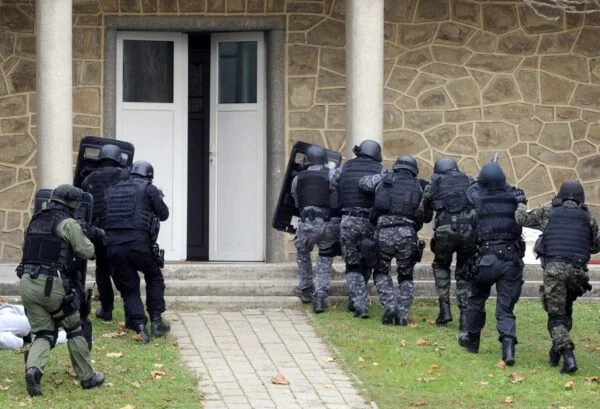Swatting Surge Tests America’s Emergency Readiness and Cybersecurity Weaknesses
Executive Summary
A recent explosion of swatting incidents targeting U.S. college campuses reveals a dangerous convergence of psychological warfare, cyber vulnerability, and overstretched public safety systems. These false active shooter calls exploit the fear of mass violence to disrupt campuses, terrorize students, and erode the credibility of emergency alerts—raising the stakes for law enforcement and national security.
Key Judgments
1. Swatting attacks on U.S. campuses are no longer isolated pranks—they resemble coordinated digital terror operations.
Evidence: From Aug. 21–26, over a dozen universities were hit with nearly identical hoax calls featuring background gunfire and mass shooting claims, overwhelming law enforcement and forcing lockdowns (WTOP, USA Today).
2. Technological sophistication and international actors may be behind this escalation, challenging domestic response capabilities.
Evidence: Use of spoofed VoIP lines, anonymized networks, and tactics previously linked to foreign and domestic swatting rings suggests deliberate efforts to test U.S. law enforcement response systems (PBS, Justice Department).
3. The psychological toll and operational costs of swatting are creating systemic vulnerabilities across higher education.
Evidence: Lockdowns traumatize students and faculty, induce alert fatigue, and have cost law enforcement over $80 million in recent years. Cases like Harvard’s 2023 swatting incident also expose racial disparities in threat response (USA Today, The Harvard Crimson).
4. Swatting has evolved into a form of hybrid threat—blending cyber, psychological, and physical security challenges.
Evidence: The Arkansas incident alone involved 300 hoax calls in a single day, likened to a denial-of-service attack by security experts. Meanwhile, livestreaming and social media bragging have turned it into digital performance terrorism (NewsNation, AP).
5. Current laws and technological safeguards are inadequate for detecting or deterring high-volume, cross-jurisdiction swatting campaigns.
Evidence: While the FBI launched a national database in 2023, enforcement remains patchy, and many perpetrators still evade identification or face light sentencing. New federal prosecutions reveal how swatting has become monetized and professionalized (DOJ, FBI).
Analysis
The late August swatting spree targeting more than a dozen U.S. college campuses marks a turning point in the evolution of this cyber-physical threat. No longer a prank pulled by disgruntled gamers, swatting has matured into a tool of psychological warfare—one that can paralyze institutions, provoke trauma, and overwhelm public safety systems without firing a single bullet.
From Pennsylvania’s Villanova University to Arizona’s NAU, these incidents followed a chillingly similar script: a male voice claims to see an AR-15-wielding gunman, often with realistic gunshot audio in the background. These reports triggered real-time lockdowns, SWAT deployments, and panicked evacuations. Although no casualties occurred, the terror inflicted on students—some of whom had already lived through real shootings—was very real. For many, the emotional toll may outlast their college years.
What’s especially concerning is the scale and synchronicity. The University of Arkansas received over 300 coordinated calls targeting multiple buildings—a digital equivalent of a physical siege. At Kansas State, the threat was identified early but still forced rapid deployment of police. In Macon, Georgia, two separate campuses were hit with simultaneous hoax threats. Experts now believe these attacks were not only organized, but likely used evolving cyber tools—such as call spoofing, anonymized routing, and even livestreaming via hacked security cameras—to create maximum panic and spectacle.
Historically, swatting grew out of the gaming world, but its migration into political, religious, and educational arenas has turned it into a form of asymmetric warfare. Perpetrators now range from solo actors to organized crews, and in some cases, include foreign nationals like Romanian swatter Thomasz Szabo, who targeted U.S. lawmakers and a former president. This is not just a law enforcement problem—it is a national security concern.
Technologically, the swatters are outpacing their pursuers. Despite the FBI’s 2023 rollout of the National Common Operational Picture (NCOP) system to track swatting, the lack of integrated, cross-jurisdictional enforcement allows perpetrators to hide behind spoofed identities and fragmented oversight. The legal penalties are inconsistent, with some receiving minimal jail time despite endangering dozens.
Strategically, the most dangerous consequence may be erosion of trust. Every false alert chips away at the legitimacy of emergency warnings. Campus officials now face the impossible task of responding swiftly while avoiding panic—a task made even harder in an age of school shootings and omnipresent trauma.
The United States must recognize swatting as more than criminal mischief—it is hybrid warfare targeting cognitive and emergency infrastructure. As with ransomware or disinformation campaigns, the goal is not just disruption, but distrust. Until policy, technology, and public awareness catch up, swatting will remain an open vector for chaos.


